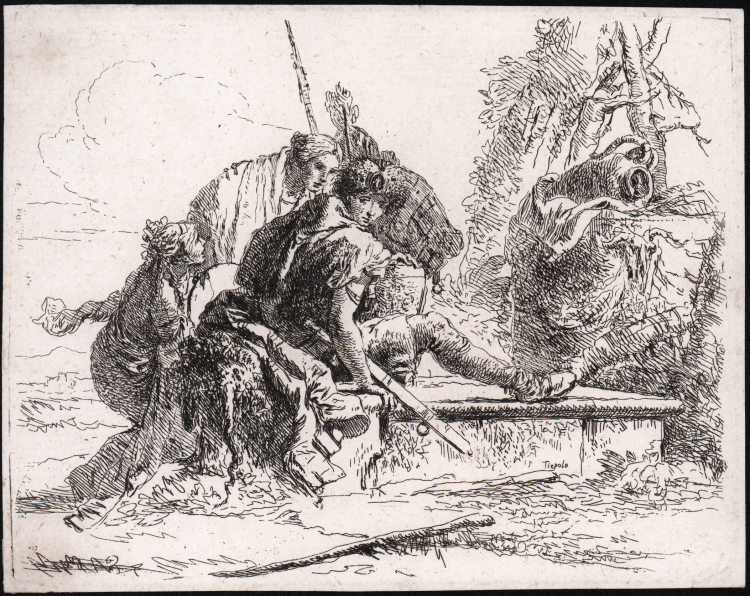




| Reference: | S47070 |
| Author | Giambattista TIEPOLO |
| Year: | 1740 ca. |
| Measures: | 172 x 134 mm |



| Reference: | S47070 |
| Author | Giambattista TIEPOLO |
| Year: | 1740 ca. |
| Measures: | 172 x 134 mm |
Etching, circa 1740/43, signed on plate at lower center Tiepolo.
From the so called Vari Capricci inventati ed incisi dal celebre Gio. Battista Tiepolo.
A good impression, printed on contemporary laid paper, with thin margins, in good condition.
“Knox (1960, n. 110) riteneva di aver individuato in un disegno del Victoria and Albert Museum "a study for the principal figure" di questo Capriccio. Ma non si tratta di uno studio preparatorio per l'incisione, perché come osservava Pignatti (1965, V), il disegno non è in controparte; esso deve considerarsi come una variazione sul tema scaturita dall'estro di Giambattista. Lo sguardo captante del giovane guerriero e la preoccupata attenzione delle due donne fanno lievitare quell'atmosfera di sottile inquietudine che Tiepolo perseguiva” (cfr. D. Succi, La Serenissima nello specchio di rame, Splendore di una civiltà figurativa del Settecento, L’opera completa dei Grandi Maestri veneti, p. 456).
Curious is the story of this series called Vari Capricci inventati ed incisi dal celebre Gio. Battista Tiepolo. The plates were stolen from a friend of his, Count Antonio Maria Zanetti, a famous engraver and collector in Venice, where they were published for the first time inserting them into the third edition of his Raccolta di Chiaroscuri in 1743. On the death of Giambattista, were published separately for the first time in 1785, probably by the Englishman John Strange, that bought the plates in the previous year by the heirs of Zanetti.
Giovanni Battista Tiepolo was one of the greatest exponents of Venetian painting of all time. At the beginning of his painting career was mainly influenced by the Piazzetta and Sebastiano Ricci. The onset of the engraving by Tiepolo dates back to the late thirties of 700, and includes the series of Capricci, consisting of ten etchings, and Scherzi di fantasia, 23 etchings carved around 1750.
Literature
A. D. Vesme, Le peintre-graveur italien: ouvrage faisant suite au Peintre-graveur de Bartsch, Milano 1906, p. 408 n. 5; A. Rizzi, L'opera grafica dei Tiepolo. Le acqueforti, Milano 1971, n. 97; D. Succi, La Serenissima nello specchio di rame, Splendore di una civiltà figurativa del Settecento, L’opera completa dei Grandi Maestri veneti, p. 456, n. 47.
Giambattista TIEPOLO (Venezia, 1696 - Madrid, 1770)
|
He was the most renowned painter of 18th-century Italy and the last great representative of the grand tradition in Italian art. He was especially gifted as a draughtsman and as a painter in fresco. His fresco cycles and religious and mythological canvases demonstrate that he also possessed a sensitive appreciation of his patrons’ requirements, together with a talent, unique in his time, to project narrative and devotional subject-matter with dramatic force. He enjoyed international patronage and painted fresco cycles that glorify such distinguished patrons as Prince Karl Philipp von Greiffenklau of Würzburg and Charles III of Spain. He also painted moving religious works—images of the Virgin, the sufferings of the saints, miracles and Old and New Testament scenes—for a wide spectrum of patrons, among them small and large confraternities, urban and provincial churches, private citizens and religious orders. Apelles Painting the Portrait of Campaspe (c. 1725–7; Montreal, Mus. F.A.) states the themes of his art. Apelles, court painter to Alexander the Great (here a self-portrait of Tiepolo), paints Campaspe, Alexander’s mistress (modelled by Cecilia Guardi). Behind them two large completed canvases, the Brazen Serpent and the Marriage of SS Cecilia and Valerian, rest against giant pilasters. Also in the background are an immense antique sculpture, the celebrated Farnese Hercules, and a distant loggia inspired by Jacopo Sansovino. The parallels are evident: like Apelles, Tiepolo worked for the ruling class. His paintings dealt with the great themes of the Western pictorial tradition, and the setting reveals his allegiance both to antiquity and to the artistic heritage of Venice.
|
Giambattista TIEPOLO (Venezia, 1696 - Madrid, 1770)
|
He was the most renowned painter of 18th-century Italy and the last great representative of the grand tradition in Italian art. He was especially gifted as a draughtsman and as a painter in fresco. His fresco cycles and religious and mythological canvases demonstrate that he also possessed a sensitive appreciation of his patrons’ requirements, together with a talent, unique in his time, to project narrative and devotional subject-matter with dramatic force. He enjoyed international patronage and painted fresco cycles that glorify such distinguished patrons as Prince Karl Philipp von Greiffenklau of Würzburg and Charles III of Spain. He also painted moving religious works—images of the Virgin, the sufferings of the saints, miracles and Old and New Testament scenes—for a wide spectrum of patrons, among them small and large confraternities, urban and provincial churches, private citizens and religious orders. Apelles Painting the Portrait of Campaspe (c. 1725–7; Montreal, Mus. F.A.) states the themes of his art. Apelles, court painter to Alexander the Great (here a self-portrait of Tiepolo), paints Campaspe, Alexander’s mistress (modelled by Cecilia Guardi). Behind them two large completed canvases, the Brazen Serpent and the Marriage of SS Cecilia and Valerian, rest against giant pilasters. Also in the background are an immense antique sculpture, the celebrated Farnese Hercules, and a distant loggia inspired by Jacopo Sansovino. The parallels are evident: like Apelles, Tiepolo worked for the ruling class. His paintings dealt with the great themes of the Western pictorial tradition, and the setting reveals his allegiance both to antiquity and to the artistic heritage of Venice.
|